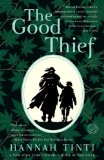Summary | Excerpt | Reading Guide | Reviews | Beyond the Book | Readalikes | Genres & Themes | Author Bio

A Novel
by Hannah TintiChapter One
The man arrived after morning prayers. Word spread quickly that someone had come, and the boys of Saint Anthony’s elbowed each other and strained to catch a glimpse as he unhitched his horse and led it to the trough for drinking. The man’s face was hard to make out, his hat pulled so far down that the brim nearly touched his nose. He tied the reins to a post and then stood there, patting the horse’s neck as it drank. The man waited, and the boys watched, and when the mare finally lifted its head, they saw the man lean forward, stroke the animal’s nose, and kiss it. Then he wiped his lips with the back of his hand, removed his hat, and made his way across the yard to the monastery.
Men often came for children. Sometimes it was for cheap labor, sometimes for a sense of doing good. The brothers of Saint Anthony’s would stand the orphans in a line, and the men would walk back and forth, inspecting. It was easy to tell what they were looking for by where their eyes went. Usually it was to boys almost fourteen, the taller ones, the loudest, the strongest. Then their eyes went down to the barely crawling, the stumbling two-year-olds—still untainted and fresh. This left the in-betweens— those who had lost their baby fat and curls but were not yet old enough to be helpful. These children were usually ill-tempered and had little to offer but lice and a bad case of the measles. Ren was one of them.
He had no memory of a beginning—of a mother or father, sister or brother. His life was simply there, at Saint Anthony’s, and what he remembered began in the middle of things—the smell of boiled sheets and lye; the taste of watery oatmeal; the feel of dropping a brick onto a piece of stone, watching the red pieces split off, then using those broken shards to write on the wall of the monastery, and being slapped for this, and being forced to wash the dust away with a cold, wet rag.
Ren’s name had been sewn into the collar of his nightshirt: three letters embroidered in dark blue thread. The cloth was made of good linen, and he had worn it until he was nearly two. After that it was taken away and given to a smaller child to wear. Ren learned to keep an eye on Edward, then James, then Nicholas—and corner them in the yard. He would pin the squirming child to the ground and examine the fading letters closely, wondering what kind of hand had worked them. The R and E were sewn boldly in a cross-stitch, but the N was thinner, slanting to the right, as if the person working the thread had rushed to complete the job. When the shirt wore thin, it was cut into bandages. Brother Joseph gave Ren the piece of collar with the letters, and the boy kept it underneath his pillow at night.
Ren watched now as the visitor waited on the steps of the priory. The man passed his hat back and forth in his hands, leaving damp marks along the felt. The door opened and he stepped inside. A few minutes later Brother Joseph came to gather the children, and said, “Get to the statue.”
The statue of Saint Anthony sat in the center of the yard. It was carved from marble, dressed in the robes of the Franciscan friars. The dome of Saint Anthony’s head was bald, with a halo circling his brow. In one hand he held a lily and in the other a small child wearing a crown. The child was holding out one palm in supplication and using the other to touch the saint’s cheek. There were times, when the sun receded in the afternoon and shadows played across the stone, that the touch looked more like a slap. This child was Jesus Christ, and the pairing was proof of Saint Anthony’s ability to carry messages to God. When a loaf of bread went missing from the kitchen, or Father John couldn’t find the keys to the chapel, the children were sent to the statue. Saint Anthony, Saint Anthony, come bring what I’ve lost back to me.
Excerpted from The Good Thief by Hannah Tinti Copyright © 2008 by Hannah Tinti. Excerpted by permission of The Dial Press, a division of Random House, Inc. All rights reserved. No part of this excerpt may be reproduced or reprinted without permission in writing from the publisher.
Your guide toexceptional books
BookBrowse seeks out and recommends the best in contemporary fiction and nonfiction—books that not only engage and entertain but also deepen our understanding of ourselves and the world around us.